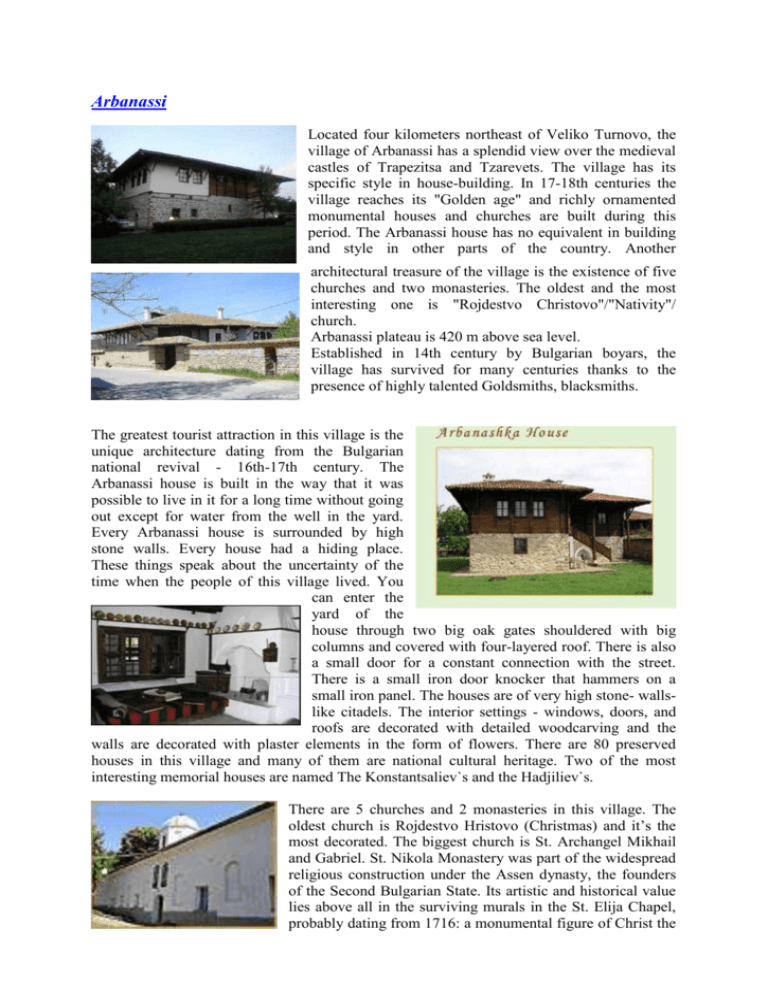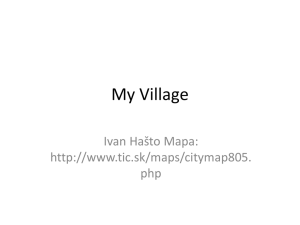Arbanassi
advertisement

Arbanassi Located four kilometers northeast of Veliko Turnovo, the village of Arbanassi has a splendid view over the medieval castles of Trapezitsa and Tzarevets. The village has its specific style in house-building. In 17-18th centuries the village reaches its "Golden age" and richly ornamented monumental houses and churches are built during this period. The Arbanassi house has no equivalent in building and style in other parts of the country. Another architectural treasure of the village is the existence of five churches and two monasteries. The oldest and the most interesting one is "Rojdestvo Christovo"/"Nativity"/ church. Arbanassi plateau is 420 m above sea level. Established in 14th century by Bulgarian boyars, the village has survived for many centuries thanks to the presence of highly talented Goldsmiths, blacksmiths. The greatest tourist attraction in this village is the unique architecture dating from the Bulgarian national revival - 16th-17th century. The Arbanassi house is built in the way that it was possible to live in it for a long time without going out except for water from the well in the yard. Every Arbanassi house is surrounded by high stone walls. Every house had a hiding place. These things speak about the uncertainty of the time when the people of this village lived. You can enter the yard of the house through two big oak gates shouldered with big columns and covered with four-layered roof. There is also a small door for a constant connection with the street. There is a small iron door knocker that hammers on a small iron panel. The houses are of very high stone- wallslike citadels. The interior settings - windows, doors, and roofs are decorated with detailed woodcarving and the walls are decorated with plaster elements in the form of flowers. There are 80 preserved houses in this village and many of them are national cultural heritage. Two of the most interesting memorial houses are named The Konstantsaliev`s and the Hadjiliev`s. There are 5 churches and 2 monasteries in this village. The oldest church is Rojdestvo Hristovo (Christmas) and it’s the most decorated. The biggest church is St. Archangel Mikhail and Gabriel. St. Nikola Monastery was part of the widespread religious construction under the Assen dynasty, the founders of the Second Bulgarian State. Its artistic and historical value lies above all in the surviving murals in the St. Elija Chapel, probably dating from 1716: a monumental figure of Christ the Great Archangel, 12 scenes from the Holy Akathistos, and 6 scenes from the life of Christ. The effective coloring and rich palette, the confidence in the portrayal of the human figures, the unusually varied architectural decoration reveals the hand of a master from a superior and more erudite school. The filigree wooden iconostasis in the chapel, with its delicate and exquisite decorations, is valuable treasure. Though situated in the same village, the Holy Virgin Monastery suffered a different, though no less tragic fate. It is not known how it survived the attacks in 1393. What has remained of them warrants the assumption that they too were painted by traveling artists - highly paid at the time, but quite affordable by the wealthy inhabitants of the village of Arbanassi. The village of Arbanassi is an architectural heritage and it’s listed among the UNESCO world heritage.








